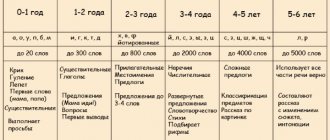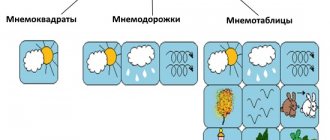Four levels of OHP
General speech underdevelopment occurs in 40% of preschool children. Speech therapists distinguish four levels of speech development:
- Level 1 – characterized by a complete absence of coherent speech. In the medical field, this condition is called “speechless children.” Babies communicate using simplified speech or babble, and also actively gesture;
- Level 2 – the initial development of general speech is observed, but the vocabulary remains poor, and the child makes a large number of mistakes when pronouncing words. In such cases, the maximum that a child can do is utter a simple sentence that will consist of no more than three words;
- Level 3 – differs in that children can compose sentences, but the semantic and sound load is not sufficiently developed;
- Level 4 is the mildest stage of the disease. This is explained by the fact that the child speaks quite well, his speech is practically no different from his peers. However, disturbances are observed during pronunciation and construction of long phrases.
3rd level of speech development: psychological characteristics
This level is characterized by greater independence of judgment. A 4-5 year old child continues to gain experience in getting to know the world around him. He still asks the adult questions, but now he has a need to express his judgments about the world around him. When reasoning, the child waits for the adult’s reaction to his judgment, thus trying to determine how correct it is. At the third level of development, rhyme creation is observed, attempts to compose a melodic phrase, a small story from simple sentences. The child becomes more sensitive to the manifestation of language capabilities in different areas of life.
Symptoms
Children with ODD speak their first words late. Usually by three or four years, sometimes by five. Speech is rarely used, sounds are pronounced incorrectly and phrases are constructed incorrectly. Others do not understand such a child well.
First level. The child cannot pronounce many sounds. Speaks in babbling words. He complements them with facial expressions and gestures, the meaning of which is difficult to understand outside the situation. Vocabulary is limited to consonances, onomatopoeia and a few words. He cannot speak in phrases and does not understand the meaning of many words.
Second level. The child distorts sounds and replaces them. Along with babbling and gestures, he begins to speak in simple sentences of up to three words. Often uses cases incorrectly and coordinates words. Peers know noticeably more words.
Third level. The child pronounces sounds and syllables, making mistakes mainly in difficult cases. Speaks in detailed phrases, but uses simple sentences, having difficulty constructing and understanding complex ones. Uses all parts of speech, but makes mistakes in prepositions and agreement. Names objects inaccurately, and also makes mistakes in cases and accents.
Fourth level. The child pronounces specific sounds and complex words with errors. The vocabulary is varied, but the child has difficulty understanding rare words, synonyms and proverbs. They have difficulty setting out a logical chain of events. They often miss the main point and get stuck on details and repeat themselves.
Causes of speech underdevelopment
The causes of speech disorders are understood as the impact of internal and external harmful factors or their complex on the body, which determines the specificity of the speech disorder.
Internal factors. Harmful effects during fetal development:
- Mother's health. Diseases suffered during pregnancy, allergies, blood transfusions, toxicosis, incompatibility of fetus and mother by blood, smoking and drinking alcohol during pregnancy, maternal age - both very young and mature, infertility treatment, abortion, complicated childbirth, stress in the family and at work, etc.) and other family members (complicated heredity: diabetes, developmental defects, genetic and mental diseases, etc.;
- Hypoxia. Insufficient oxygen supply. With placental insufficiency and during childbirth, the maturation of brain structures is disrupted in the fetus.
- Birth injury. Direct mechanical effects on the fetus during childbirth, causing local damage to the fetus and impaired brain function.
External factors. The immediate conditions in which a child grows and develops:
- general physical weakness of the body (asthenia, rickets, metabolic disorders, diseases of internal organs, diseases of the central nervous system (CNS), as well as severe course of any diseases, including colds, and complications after them);
- unfavorable upbringing conditions (lack of an emotionally positive environment, fear, a traumatic situation in the family, long-term separation from loved ones, any neuropsychiatric diseases and injuries);
- disturbances in the speech of surrounding adults (the speech of children develops by imitation: stuttering, impaired speech rate, unclear pronunciation, including exaggerated childish speech - “lisping” can be absorbed by the child);
- lack of verbal communication with a child under one year old (when they do not talk to the child, explaining this by, for example, that he does not understand).
Mechanisms
Insufficient speech development in a preschooler is a systemic disorder. Patients with this level of development are far behind their peers. If this process is left to chance, the child will not be able to study at school; he will experience not only difficulties in mastering the school curriculum, but also psychological discomfort.
The mechanism of formation of this pathology is associated with one or another lesion of the central nervous system (for example, fetal hypoxia during pregnancy, asphyxia during childbirth, head trauma).
Primary speech therapy examination
Let us describe how the initial examination of the OHP is carried out. First, the speech therapist gets acquainted with the notes of the child neurologist and pediatrician. Clarifies the features of the course of early speech development.
Then he diagnoses oral speech and determines the degree of formation of the language system. Studies the state of coherent speech: composing a story from a picture, retelling.
Examines the correctness of word formation, coordination of parts of speech and sentence construction. Determines the vocabulary and ability of children to correctly name objects or phenomena.
Studies the sound side of speech: the structure and motor skills of the speech apparatus, sound pronunciation, syllable structure and sound content of words. Determines abilities for phonemic perception, sound analysis and synthesis. Conducts diagnostics of auditory-verbal memory and other mental processes.
The conclusion helps to determine suitable correction techniques
The result of the examination is a speech therapy report. It reflects the level of speech development and the clinical form of speech disorder.
For example: level 2 OHP in a child with a motor form of alalia.
The diagnosis after “ONR” must necessarily indicate what clinical diagnosis is causing the speech underdevelopment. The conclusion helps determine appropriate corrective techniques.
Levels of speech development (according to R.E. Levina)
Level 1 of speech development, characterized in the literature as “lack of commonly used speech,” is the most persistent and specific speech underdevelopment, often caused by motor alalia. With this form of speech pathology, children have damage (or underdevelopment) of the cortical speech areas of the brain, and primarily Brocca's area.
Quite often, when describing the speech capabilities of children at this level, the name “speechless children” is used, which cannot be taken literally, since such a child uses a number of verbal means in independent communication. These can be individual sounds and some of their combinations - sound complexes and onomatopoeia, snatches of babbling words (“mud”, “sina” - “machine”).
Sometimes a babbling word is completely different from its original, since the child is able to correctly convey only the prosodic features of its pronunciation - stress, number of syllables, intonation, etc. (“tutya” - “hand”). These facts indicate an extreme poverty of vocabulary, as a result of which the child is forced to resort to the active use of paralinguistic (i.e., non-linguistic) means - gestures, facial expressions.
In children of the 1st level of speech development, the phonetic-phonemic aspect of speech is characterized by phonemic uncertainty and unstable phonemic design. The pronunciation of sounds is diffuse, which is due to unstable articulation and low auditory recognition capabilities. Such children may have more defective sounds than correctly pronounced ones.
In the pronunciation of children at this level of speech development, only vowels - consonants, orals - nasals, plosives - fricatives are opposed to each other. Phonemic development is in its infancy: the task of isolating individual sounds for a child with such development is incomprehensible and impossible.
These children, in addition to a specific defect, are characterized by disturbances of attention, memory, thinking, disorders of the emotional-volitional sphere and behavior.
Children with level 1 speech development receive speech therapy assistance from 2.5 to 3 years of age in specialized groups or kindergartens for children with general speech underdevelopment.
Level 2 of speech development is defined in the literature as “the beginnings of common speech.” In these children, general speech underdevelopment is combined with a number of neurological and psychopathological syndromes.
A clinical and psychological-pedagogical examination of children of the 2nd level reveals the presence of characteristic disorders of cognitive activity in them, caused both by the speech defect itself and by low mental performance.
In children's independent speech, simple prepositions and their babbling variants sometimes appear. However, some simple prepositions (“on”, “above”, “for”, etc.) and complex ones (“because of”, “from under”, “through”, “between”, “about”) cause difficulties in understanding, differentiation and, of course, use.
Compared to the previous level, there is a noticeable improvement in the state of vocabulary not only in quantitative, but also in qualitative parameters; the scope of used nouns, verbs and adjectives is expanding; some numerals and adverbs appear, etc.
The speech of children with level 2 often seems incomprehensible due to gross violations of sound pronunciation and the syllabic structure of words.
When reproducing words of two or three or more syllables, children disrupt their sequence, rearrange them, omit or, conversely, add syllables, and distort their sound (“siped” - “bicycle”, “kititi” - “bricks”).
The phonemic aspect of the speech of children at the 2nd level of speech development is characterized by the presence of many distortions, substitutions and confusions; They have impaired pronunciation of soft and hard sounds, hissing, whistling, affricates, voiced and voiceless. At the same time, children can pronounce sounds that are in an isolated position correctly; errors occur during spontaneous pronunciation. When correctly reproducing the contour of words, their sound content is disrupted (“morashki” instead of chamomile).
One of the characteristic features of children at this level of speech development is a lack of phonemic perception and unpreparedness for mastering the skills of sound analysis and synthesis.
The 3rd level of speech development is characterized by extensive phrasal speech with elements of underdevelopment of vocabulary, grammar, phonetics, without other pronounced disorders of neuropsychic activity. These children do not have local lesions of the central nervous system. There are no clear indications in their anamnesis of significant deviations in the course of pregnancy and childbirth. In only one third of the subjects, a detailed conversation with the mother reveals evidence of mild toxicosis in the second half of pregnancy or short-term asphyxia during childbirth. In these cases, one can often note the prematurity or immaturity of the child at birth, his somatic weakness in the first months and years of life, and susceptibility to infectious diseases.
In the mental appearance of these children, certain features of general emotional-volitional immaturity and weak regulation of voluntary activity are noted.
Typical for this level is an inaccurate understanding and use of general concepts, words with abstract and abstract meanings, as well as words with a figurative meaning.
Phonemic underdevelopment of children in this group is manifested in the immaturity of the processes of differentiation of sounds: children have difficulty completing tasks to identify the first and last sound in a word, select pictures whose names contain a given sound, etc. Thus, in a child with the 3rd level of speech development, the operations of sound-syllable analysis and synthesis are insufficiently formed, and this, in turn, will serve as an obstacle to mastering reading and writing.
4th level of speech development
This includes children with mildly expressed residual manifestations of lexical-grammatical and phonetic-phonemic underdevelopment of speech. Minor violations of all components of the language are identified during a detailed examination when performing specially selected tasks.
In the speech of children, there are isolated violations of the syllabic structure of words and sound content. Eliminations predominate (indistinct pronunciation or omission of a sound in order to make pronunciation easier for the speaker), and mainly in the reduction of sounds and only in isolated cases - omission of syllables. Paraphasias are also noted (replacement or rearrangement of required sounds, syllables of speech or words with others), more often - rearrangements of sounds, less often - syllables; a small percentage of perseveration (sustained repetition of a phrase) and the addition of syllables and sounds. Insufficient intelligibility, expressiveness, somewhat sluggish articulation and unclear diction leave the impression of general blurred speech. The incompleteness of the formation of the sound-syllable structure and the mixing of sounds characterize the insufficient level of differentiated perception of phonemes. This feature is an important indicator of the process of phoneme formation that has not yet completed.
Underdevelopment of phonemic perception is noted when performing elementary actions of sound analysis - when recognizing a sound, coming up with a word for a given sound.
Appendix 2
Characteristics of games
I. Games for hearing development.
These games serve to develop hearing, speech and breathing. They prepare the child to perceive sounds and the correct articulation necessary to reproduce them.
Therefore, games for the development of hearing (speech hearing) come first. The selection of games is carried out in a strict sequence: first, games for the development of auditory attention, i.e. the ability to distinguish non-speech sounds (noises, sound toys, knocking, rustling), then determining the direction of the sound.
Example: “Where is it ringing?”, “Where did they knock?”, “Blind man’s buff with a bell”, “Who heard what?”, “Tell me what you hear?”.
Then there are games for the development of speech hearing, i.e. the child’s ability to distinguish people’s voices and understand the meaning of the speaker’s phrases. The next stage will be games for the development of phonemic awareness, i.e. ability to hear and distinguish speech sounds. Correct pronunciation of sounds requires coordinated, precise work of all moving parts of the articulatory apparatus: tongue, lips, lower jaw, soft palate. This also includes games for developing voice and breathing.
These games can be called preparatory games.
II. Games to develop correct sound pronunciation.
As they correct sounds, their goal These can be games - onomatopoeia, sentences, short poems.
These games are often combined with movement development, i.e. while pronouncing words, certain movements are made - in meaning, they are also combined with the development of auditory attention, when children must respond to certain words with some kind of movement. And, of course, correctly pronounce the assigned sounds during the game.
These games are often multi-purpose.
III. Didactic board games.
These games are designed to reinforce sounds in words, sentences, and connected text, to improve vocabulary and phrasal speech. They can act both as the main lesson and as the beginning or end of the lesson. Didactic games are also carried out for the purpose of mental education.
IV. Nursery rhymes, counting rhymes, riddles.
Nursery rhymes, rhymes, and riddles are designed to reinforce correct sound pronunciation. They develop auditory memory and expressive speech.
V. Games - dialogues.
The expressiveness of speech, facial expressions, gestures, movements that imitate characters are developed, and the set sounds are reinforced.
When conducting speech games, you need to set up the children before the game, talk about the characters of the games, create an emotional mood, use attributes or costumes. Follow the rules of the game, constantly reminding children of this. Give feedback after the game; focus on the positive aspects; discuss why something didn't work out. After the games have been mastered, make the children (preparatory, senior groups) the leaders.
Appendix 3
OHP correction
Speech therapy work depends on the level of speech development. Thus, the main directions for level 1 OSD are the development of understanding of addressed speech, activation of independent speech activity and non-speech processes: attention, memory and thinking.
With level 1 OHP, attention is paid to the grammatical side of speech, but the task of correct phonetic formatting of the statement is not set.
With OHP level 2, speech activity and understanding of speech, lexical and grammatical means of language, phrasal speech and clarification of sound pronunciation and evocation of missing sounds are developed.
With OHP level 3, they develop coherent speech and improve the lexical and grammatical aspects of speech. Reinforce correct sound pronunciation and phonemic awareness. At this stage, attention is paid to preparing for the acquisition of literacy.
At level 4 OHP, children are taught until they reach the age standard of oral speech necessary for successful schooling. To do this, they improve pronunciation, vocabulary and grammar, and detailed phrasal speech. Develop primary reading and writing skills.
In schools for children with severe speech impairments, they study with severe forms of ODD levels 1-2. Children with level 3 ODD study in special education classes at a regular school. With OHP level 4 - in regular classes.
Diagnostics
The diagnosis of level 1 OHP should be made on the basis of a comprehensive examination. The final decision is made by a speech therapist or defectologist. To draw up an accurate picture and study the anamnesis, consultations with the following specialists will be required:
- Neurologist: evaluates the general conditions of the central nervous system.
- Pediatrician: Gives a description of the child's general health from birth to this period.
- Psychologist: assesses the child's sensory, motor and intellectual development.
The speech therapist studies the conclusions of highly specialized doctors and draws up his own picture of the child’s speech state during a conversation with the child and parents. This work is carried out in several stages:
- A child’s development chart is filled out from the parents’ words and descriptions of physical health compiled by a pediatrician. The speech therapist gets to know the preschooler and establishes contact.
- The components of the baby’s speech, motor skills during conversation and play are studied.
- Manifestations of the defect in dynamic observation are clarified. The child is asked questions that require a detailed answer, his level of curiosity and desire to communicate are assessed.
- The syllabic and sound structure of the word, the coherence of speech, and the correctness of grammatical structure are carefully examined.
If a child is diagnosed with general speech underdevelopment of level 1, he needs to be referred to a speech therapy group in a kindergarten. The certificate is issued by the PMPK (psychological-medical-pedagogical commission). The conclusion about referral for speech therapy help in a preschool institution is given on the basis of examinations by specialized specialists, including a speech therapist.
At an advanced stage of mental retardation, level 1-2 OHP, you can apply for disability for a period of 1 year or longer. You need to pass the PMPC, VTEC (medical and labor expert commission). Disability benefits are a good way to pay for the services of a speech pathologist and speech therapist.










